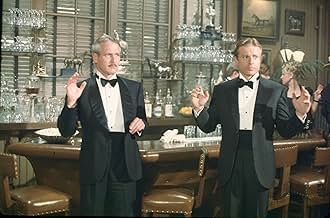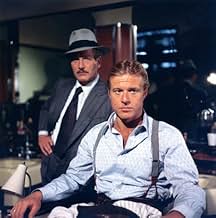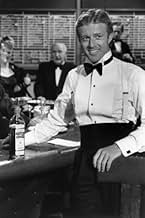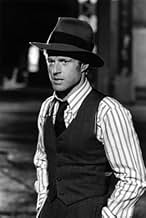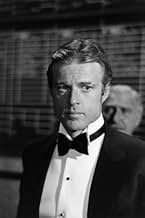Deux escrocs font équipe pour réaliser l'arnaque du siècle.Deux escrocs font équipe pour réaliser l'arnaque du siècle.Deux escrocs font équipe pour réaliser l'arnaque du siècle.
- Réalisation
- Scénario
- Casting principal
- Récompensé par 7 Oscars
- 18 victoires et 6 nominations au total
Robert Earl Jones
- Luther Coleman
- (as Robertearl Jones)
James Sloyan
- Mottola
- (as James J. Sloyan)
Résumé
Reviewers say 'The Sting' is celebrated for its intricate plot, charismatic performances by Paul Newman and Robert Redford, and nostalgic charm of the 1930s setting. The film's clever con schemes, dynamic character interactions, and witty dialogue are frequently highlighted. The iconic ragtime music enhances the atmosphere, while meticulous production design immerses viewers. Despite some criticisms regarding historical inaccuracies and predictability, 'The Sting' is widely regarded as a timeless classic.
Avis à la une
10moman818
A magical plot, dead on art direction, brilliant supporting roles (most notably Robert Shaw, ya falla?), and the guiding hand of Redford/Newman chemistry make this one of the Hollywood's great films. "The Sting" is a hallmark of the "Golden Age" of American film, and has molded not only countless films, but numerous genres, few of which have met the challenge of its master.
Doyle Lonnegan (brilliantly played by Robert Shaw) is a mean and vengeful villain, his retribution leads to you, losing a friend (he's after you too), you find your way to Henry Gondorff (coolly performed by Paul Newman), a sting is conjured around a horse (or horses), then you gather several cons, play let's pretend. The irritation is lieutenant William Snyder (played by the excellent Charles Durning), he's on your tail, and it's not long, before he'll find you, but there are ways to cause distractions, to pervert his satisfactions, as Johnny Hooker (Robert Redford nails it to perfection) you deliver quite a blinder.
Perpetual perfection that continues to deliver to this day.
Perpetual perfection that continues to deliver to this day.
The Sting, evoking a bygone era of gangsters and con men, was the deserved Best Picture of 1973. The Sting won that Oscar plus a whole flock of technical awards. One award it didn't win was for Robert Redford as Best Actor.
That must have been tough for the Academy voters because to single out Redford as opposed to Paul Newman must have felt a bit unjust. For though Newman was nominated many times over his career and finally did win for The Color of Money, did not get a nomination for The Sting.
Robert Redford is a small time grifter who while working a bait and switch street con takes off a numbers runner carrying the weekly take. The orders come down from the head man himself, Irish-American gangster Robert Shaw to kill those who did this as an example.
Redford's mentor, Robert Earl Jones, is in fact killed, mainly because Redford starts spending a lot of that newly acquired loot that tips them off. Redford wants revenge so he looks up big time con man Paul Newman who himself is dodging law enforcement as is Redford also.
They work the big con on Shaw and it's a beauty. The scheme they have is something to behold. They also have to do a couple of improvisations on the fly that lend a few twists to the scheme.
The costumes and sets really do evoke Chicago of the Thirties and director George Roy Hill assembles a great cast to support Newman and Redford. My favorite in the whole group is Charles Durning, who plays the brutally corrupt, but essentially dumb cop from Joliet who nearly gums up the works and has to be dealt with.
Special mention should also go to Robert Shaw. He's got a difficult part, maybe the most difficult in the film. He's not stupid, he would not have gotten to the top of the rackets if he was. But he also has to show that hint of human weakness that Newman, Redford, and the whole mob they assemble that makes him vulnerable to the con.
During the sixties and seventies Robert Shaw was really coming into his own as a player, getting more and more acclaim for his work. His early death was a real tragedy, there was so much more he could have been doing.
Can't also forget another co-star in this film, the ragtime music of Scott Joplin that was used to score The Sting. It probably is what most people remember about The Sting. Music from the Theodore Roosevelt era, scoring a film set in the Franklin Roosevelt era made while Nixon was president. Strange, but it actually works.
The Sting still works wonders today.
That must have been tough for the Academy voters because to single out Redford as opposed to Paul Newman must have felt a bit unjust. For though Newman was nominated many times over his career and finally did win for The Color of Money, did not get a nomination for The Sting.
Robert Redford is a small time grifter who while working a bait and switch street con takes off a numbers runner carrying the weekly take. The orders come down from the head man himself, Irish-American gangster Robert Shaw to kill those who did this as an example.
Redford's mentor, Robert Earl Jones, is in fact killed, mainly because Redford starts spending a lot of that newly acquired loot that tips them off. Redford wants revenge so he looks up big time con man Paul Newman who himself is dodging law enforcement as is Redford also.
They work the big con on Shaw and it's a beauty. The scheme they have is something to behold. They also have to do a couple of improvisations on the fly that lend a few twists to the scheme.
The costumes and sets really do evoke Chicago of the Thirties and director George Roy Hill assembles a great cast to support Newman and Redford. My favorite in the whole group is Charles Durning, who plays the brutally corrupt, but essentially dumb cop from Joliet who nearly gums up the works and has to be dealt with.
Special mention should also go to Robert Shaw. He's got a difficult part, maybe the most difficult in the film. He's not stupid, he would not have gotten to the top of the rackets if he was. But he also has to show that hint of human weakness that Newman, Redford, and the whole mob they assemble that makes him vulnerable to the con.
During the sixties and seventies Robert Shaw was really coming into his own as a player, getting more and more acclaim for his work. His early death was a real tragedy, there was so much more he could have been doing.
Can't also forget another co-star in this film, the ragtime music of Scott Joplin that was used to score The Sting. It probably is what most people remember about The Sting. Music from the Theodore Roosevelt era, scoring a film set in the Franklin Roosevelt era made while Nixon was president. Strange, but it actually works.
The Sting still works wonders today.
I agree 100 percent that this is a wonderful movie. I first saw it over 30 years ago, and it remains vivid in my mind while I can't remember zip about movies I saw last week which others have praised and I found wanting. I can't think of another film about double and triple crosses that deserves to be mentioned in the same sentence with "The Sting" (which doesn't mean that some of the others haven't been good). In addition to all the things that others have praised, one of the most memorable features of this film is the use of a Scott Joplin rag, which both lends a distinctive period touch and adds a sense of fast-paced motion to the action. I'm not much for ranking films -- top five, top ten, top 250 -- but this is one of the best. If you haven't already seen it, drop everything and find the DVD. As pure entertainment, it can't be beat.
The fix is in, the odds are set, and the boys are ready to play for the big time, both on the screen and behind the camera in this breezy, endlessly entertaining movie classic.
Robert Redford is small-time hustler Johnny Hooker, happy to play the marks in Joliet until the murder of his mentor pushes him to go up against the nastiest mug in Chicago, Doyle Lonnegan (Robert Shaw.) Hooker'd rather ice Lonnegan outright, but will settle for a big con with the help of a slightly wobbly but game scammer named Henry Gondorff, played as only Paul Newman can.
Newman and Redford, along with director George Roy Hill, had a lot riding on this pony, given it was a follow-up to their earlier "Butch Cassidy And The Sundance Kid." To measure up, they had to produce nothing short of another classic. And so they did. "The Sting" won the Best Picture Oscar in 1973, and remains the sentimental favorite among many in choosing between the two films.
Comparing "The Sting" to "Butch Cassidy" is kind of overdone sport, and tempers, as Lonnegan would say, run hot. But you can see why "The Sting" worked as well as it did by looking at how the director and the stars played it differently within the same basic framework as "Butch Cassidy." Newman and Redford are again outlaws and underdogs. Period detail abounds here as it did with "Butch Cassidy," and there's another memorable score amid the proceedings, Scott Joplin rags modernized by Marvin Hamlisch. The score even produced another hit, "The Entertainer," to compare with "Raindrops Keep Falling On My Head."
What's different about "The Sting," and what makes it such a classic in its own right, is the way the stars service the plot. In "Butch Cassidy," Newman and Redford's comradeship was the story. Here, the chemistry between the two actors is minimized in favor of spinning a yarn with enough red herrings to feed the Swedish navy. The tale here is better than "Butch Cassidy," which is a more elegiac film with grander cinematography and funnier set pieces. "The Sting" is an edge-of-your-seat caper flick from beginning to end.
You can't really call "The Sting" a comedy. Though there are many laughs, especially when Newman hooks Shaw during a poker game, Hill won't let the audience relax enough for that. What this is is a con game, played on the audience, designed not to cheat but entertain by means of clever hoodwinking and constant misdirection plays.
You'll get no spoilers from me. This is one worth sitting through with no expectations. Five gets you ten you'll enjoy Newman and Redford, and a terrific supporting cast (one advantage over "Butch Cassidy") that includes Charles Durning, Eileen Brennan, Dana Elcar, Harold Gould, and Mr. Hand himself, Ray Walston. There's another familiar face from "Butch Cassidy," Charles Dierkop, Flat Nose Curry in "Butch Cassidy" and Lonnegan's right hand here. The best performance may be Robert Shaw's; he exudes menace aplenty but some humanity, too, when he takes Hooker under his wing after learning he came from the same hard streets of Five Points Lonnegan sprang from.
Terrific period detail, too. The dialogue is great and feels real in its Runyonesque way, while the cons are elaborate and logically played out. Watching this a second time is especially fun because once you know how the plot goes down, you find yourself catching clues you missed the first time, and enjoying the film even more for them.
Why didn't Newman and Redford team up again? Certainly there was another good movie for them to partner up in, but as Gondorff would have put it, only chumps don't quit when they're ahead.
Robert Redford is small-time hustler Johnny Hooker, happy to play the marks in Joliet until the murder of his mentor pushes him to go up against the nastiest mug in Chicago, Doyle Lonnegan (Robert Shaw.) Hooker'd rather ice Lonnegan outright, but will settle for a big con with the help of a slightly wobbly but game scammer named Henry Gondorff, played as only Paul Newman can.
Newman and Redford, along with director George Roy Hill, had a lot riding on this pony, given it was a follow-up to their earlier "Butch Cassidy And The Sundance Kid." To measure up, they had to produce nothing short of another classic. And so they did. "The Sting" won the Best Picture Oscar in 1973, and remains the sentimental favorite among many in choosing between the two films.
Comparing "The Sting" to "Butch Cassidy" is kind of overdone sport, and tempers, as Lonnegan would say, run hot. But you can see why "The Sting" worked as well as it did by looking at how the director and the stars played it differently within the same basic framework as "Butch Cassidy." Newman and Redford are again outlaws and underdogs. Period detail abounds here as it did with "Butch Cassidy," and there's another memorable score amid the proceedings, Scott Joplin rags modernized by Marvin Hamlisch. The score even produced another hit, "The Entertainer," to compare with "Raindrops Keep Falling On My Head."
What's different about "The Sting," and what makes it such a classic in its own right, is the way the stars service the plot. In "Butch Cassidy," Newman and Redford's comradeship was the story. Here, the chemistry between the two actors is minimized in favor of spinning a yarn with enough red herrings to feed the Swedish navy. The tale here is better than "Butch Cassidy," which is a more elegiac film with grander cinematography and funnier set pieces. "The Sting" is an edge-of-your-seat caper flick from beginning to end.
You can't really call "The Sting" a comedy. Though there are many laughs, especially when Newman hooks Shaw during a poker game, Hill won't let the audience relax enough for that. What this is is a con game, played on the audience, designed not to cheat but entertain by means of clever hoodwinking and constant misdirection plays.
You'll get no spoilers from me. This is one worth sitting through with no expectations. Five gets you ten you'll enjoy Newman and Redford, and a terrific supporting cast (one advantage over "Butch Cassidy") that includes Charles Durning, Eileen Brennan, Dana Elcar, Harold Gould, and Mr. Hand himself, Ray Walston. There's another familiar face from "Butch Cassidy," Charles Dierkop, Flat Nose Curry in "Butch Cassidy" and Lonnegan's right hand here. The best performance may be Robert Shaw's; he exudes menace aplenty but some humanity, too, when he takes Hooker under his wing after learning he came from the same hard streets of Five Points Lonnegan sprang from.
Terrific period detail, too. The dialogue is great and feels real in its Runyonesque way, while the cons are elaborate and logically played out. Watching this a second time is especially fun because once you know how the plot goes down, you find yourself catching clues you missed the first time, and enjoying the film even more for them.
Why didn't Newman and Redford team up again? Certainly there was another good movie for them to partner up in, but as Gondorff would have put it, only chumps don't quit when they're ahead.
Oscars Best Picture Winners, Ranked
Oscars Best Picture Winners, Ranked
See the complete list of Oscars Best Picture winners, ranked by IMDb ratings.
Le saviez-vous
- AnecdotesPaul Newman and Robert Redford were each paid $500,000 for their role, the highest rate for an actor working at that time. Adjusted for inflation, that is equal to about $3 million (2022). The year before this Marlon Brando earned $3 million from Le Dernier Tango à Paris (1972) but that included profit participation.
- GaffesIn the bathroom, Hooker can be seen saying, "He didn't tell me you was a fuck-up either." This has been looped to replace it with the less profane "He didn't tell me you was a screw-up either." (The grammar error is scripted.)
- Citations
Johnny Hooker: Can you get a mob together?
Henry Gondorff: After what happened to Luther, I don't think I can get more than two, three hundred guys.
- Crédits fousThe opening animated logo for Universal Pictures is in 1930s style, matching the movie's setting, instead of the 1970s version.
- ConnexionsFeatured in Oscars, Actors and The Exorcist (1974)
Meilleurs choix
Connectez-vous pour évaluer et suivre la liste de favoris afin de recevoir des recommandations personnalisées
Détails
Box-office
- Budget
- 5 500 000 $US (estimé)
- Montant brut aux États-Unis et au Canada
- 156 000 000 $US
- Montant brut mondial
- 156 000 000 $US
- Durée
- 2h 9min(129 min)
- Couleur
- Rapport de forme
- 1.85 : 1
Contribuer à cette page
Suggérer une modification ou ajouter du contenu manquant




